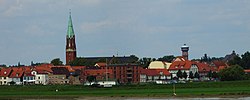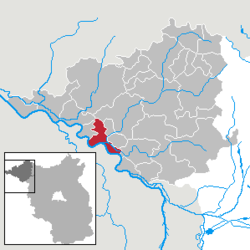Wittenberge
| Wittenberge | ||
|---|---|---|
 |
||
|
||
| Coordinates: 53°00′N 11°45′E / 53.000°N 11.750°ECoordinates: 53°00′N 11°45′E / 53.000°N 11.750°E | ||
| Country | Germany | |
| State | Brandenburg | |
| District | Prignitz | |
| Government | ||
| • Mayor | Oliver Hermann (—) | |
| Area | ||
| • Total | 50.44 km2 (19.47 sq mi) | |
| Population (2015-12-31) | ||
| • Total | 17,206 | |
| • Density | 340/km2 (880/sq mi) | |
| Time zone | CET/CEST (UTC+1/+2) | |
| Postal codes | 19322 | |
| Dialling codes | 03877 | |
| Vehicle registration | PR | |
| Website | www.wittenberge.de | |
Wittenberge (German pronunciation: [ˌvɪtənˈbɛɐ̯ɡə]) is a town of eighteen thousand people on the middle Elbe in the district of Prignitz, Brandenburg, Germany.
Wittenberge is situated at the right (north-eastern) bank of the middle Elbe at its confluence with the Stepenitz and Karthane in the German district of Prignitz. Within the same district, the town borders the Ämter Lenzen-Elbtalaue and Bad Wilsnack/Weisen as well as the district capital Perleberg. The Verbandsgemeinde Seehausen (Altmark) in the district of Stendal, Saxony-Anhalt, lies on the opposite side of the Elbe.
The site was marked out in 1239 at Wendischwalde and in 1300 the Saxon king, Otto I, established the settlement. It grew slowly but steadily. The town castle (1669) survives as the town museum but it suffered fires in 1686 and 1757, and floods from the Elbe in 1709 and 1761. Nevertheless, because of its position, it prospered from the opening of the Berlin–Hamburg steamship traffic. By 1823 milling, processing and refining of foodstuffs were important industries. In 1846 the railway came and a silk factory was built, followed by a chemical factory in 1849. The Reichsbahn railway workshops were established in 1875 and the world-famous Singer Sewing Machine Company set up there in 1903. By 1914 the Rathaus was built.
...
Wikipedia



